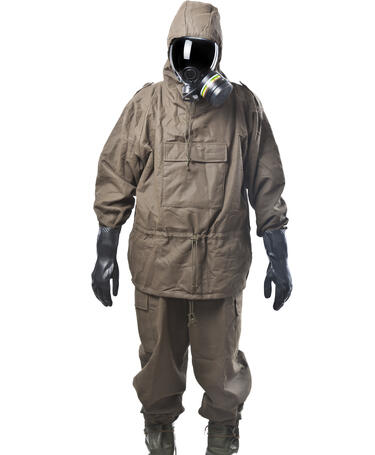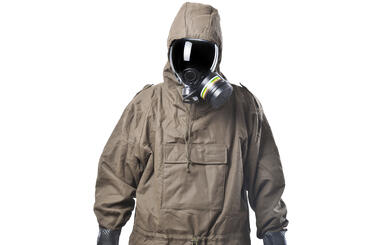
Assuring against Ebola
Progress indicator

Natasha Cowan spoke to Colonel Chris Gibson to find out how he used innovative quality techniques to stop the Ebola virus in its tracks.
In 2014, the Ebola crisis had reached critical proportions. By October the death toll was 4,447 and the World Health Organisation (WHO) reported the number of new cases would reach between 5,000 and 10,000 a week by early December. Doctor Bruce Aylward, the WHO assistant director general put the death rate at 70 per cent.
After a plea for help from the director of the aid organisation Medecins Sans Frontieres, military intervention was seen as the only option for helping to fight against the virus and Operation Gritrock was born.
The Ministry of Defence, under the Department of International Development, tasked the Defence Medical Services with creating a new treatment centre in Sierra Leone, one of the countries devastated by the virus. The objective was to assure the safety of Ministry of Defence personnel while saving the lives of patients.
The CQI spoke to Colonel Chris Gibson to find out how the team achieved success gaining them the highest performance grade ever from WHO.
What was your task during Operation Gritrock?
Colonel Chris Gibson: When Operation Gritrock started I was chief instructor of the Army Medical Services Training Centre in York. I was tasked to design a strategy for assuring the safety all military personnel deploying to Sierra Leone to help fight against the Ebola Virus Disease outbreak.
The Medical Directorate provided expertise in infection prevention control, understanding the proliferation of the virus and the protection of our people while operating in an extremely dangerous environment. The aim was to make sure our people could help those suffering from the disease without becoming contaminated and thus a casualty themselves.
Why did the Ministry of Defence decide the operation was crucial?
In November 2014 the Ebola epidemic had reached a crisis level and the only way to solve this crisis was with military intervention – no other organisation was large enough or had the holistic capability to provide an impact.
Epidemiology suggested the capital of Sierra Leone was under threat of collapse to the virus, so we had to act fast to support those in need and the other government departments asking for support.
What was the greatest challenge?
When I asked the question: ‘How does an Ebola hospital delivering a UK standard of care work in Africa?’ Nobody could tell me the answer – it had never been done before.
However, the real challenge was measuring success and assuring our people against an invisible and deadly virus.
What was your strategy for training your team?
I had a full replica of the hospital in Camp Bastion Afghanistan so I started by dismantling it to try and work out what the hospital would look like.
We employed subject matter experts in Ebola and military doctors working in Guinea to give us their perspective. We also brought back patients who had Ebola and then recovered, and we brought in military planners from The Permanent Joint in London [the British headquarters where all military operations are controlled] to give us their advice on how they saw the operation unfolding.
Next, we knew we had to test every single component of the hospital and every situation that could occur. We created an eight-day training event and worked in micro simulation and miso simulations, where we build the team’s knowledge, skills and attitudes towards the disease and show our people how to protect ourselves in such a hostile environment.
Then we finished with a CAP Stone component of macro simulation. We used a systems approach to do an end-to-end assurance of our capability including all of the physics and chemistry of a functioning hospital.
How did you provide assurance against an invisible virus?
Assuring the safety of our people going out to Sierra Leone was crucial. Our team worked tirelessly with Public Health England and The National Ambulance Resilience Unit to create a new personal protective equipment suit that really worked.
The current equipment was industrial – it only allowed you to operate in an Ebola virus facility for around 20 minutes because in Sierra Leone it can be 38 degrees Celsius and 98 per cent humidity. The suit also limited the dexterity of our clinicians, which hampered them when they were carrying out critical procedures such as putting in a central line to provide nutrients to dehydrated patients or administrating intravenous fluids.
We also created more than 700 key performance indicators, which were measured every day and then we revisited the results on a daily basis to elevate performance. At the end of each day we sat down with subject matter experts and conducted a Judgment Panel, where we identified risks and decided how we would tackle them.
Then we used a risk matrix called the four Ts – which assessed whether we treat, tolerate, transfer or terminate the risks – it’s a very agile method.
At the end of the three-day training event we brought in a One Star Brigadier who analyses each day of results and they then decide whether the capability was fit to deploy or not. Last, we produced a report to highlight our findings, which was signed off by the Competent Medical Authority.
We treated more than 100 people with Ebola Virus disease – the team and all those involved in this process did a fantastic job.
CQI and IRCA members can read more about these issues in the June edition of Quality World.
Member only

This article is free to access for a limited time only. Only CQI and IRCA members receive access to all content.
Get the full story

Enjoyed the article? You can find more stories like this in Quality World.